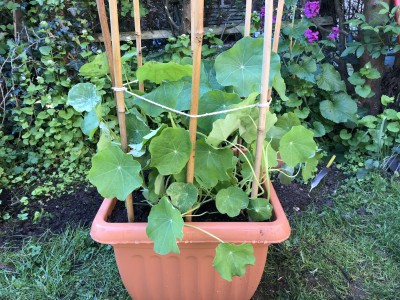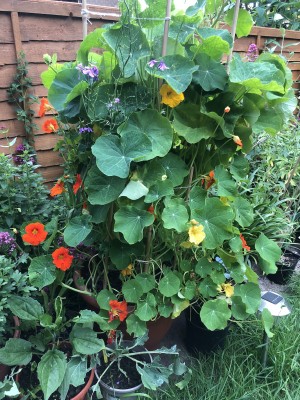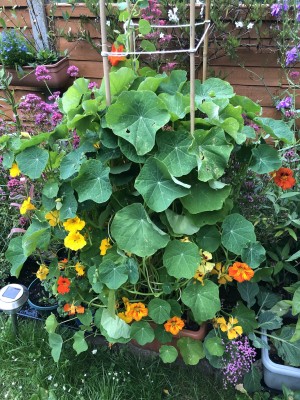Early Grown "June Gap" Nasturtiums (for aesthetic appeal & seed collecting later)
"June Gap" did not reference a specific cultivar, but a plant's full flower timing, for when there were less Cabbage white butterflies, which were in-between Spring and Summer generations. The nasturtiums were grown from seed indoors to begin with from the beginning of March, outdoors under plastic in April, uncovered from under plastic at beginning of May. When first uncovered from plastic, leaves were kept water misted and plants watered in the shade first, to allow to acclimatise (adjusted to less air humidity). Plants were encouraged to climb.

- April 30th 2022

- June 14th 2022

- June 14th 2022
June 14th 2022. Flowering plants to be kept well watered and fed, some of the older yellowing leaves, which had lost much of their energy providing capacity (and using up light-space) were removed, for aesthetic appeal also.
Think of them, a bit like an early grown tomato plant (grown early, avoiding frost damage, for fruiting longevity).
Gardening for Butterfly Ovipositors
June 14th 2022
Some "broadleaf" native grass (as compared with narrow leaved lawn grass) was kept at the back of a garden, to help with a life cycle of a Speckled wood butterfly. When one was lucky enough to have a colony of "Trefoil Blue" butterflies nearby and grew bird's foot trefoil in their garden, to promote their life cycles, in Lincolnshire, it was coming into flower, so was kept watered and fed.
Consider watering brassica vegetables (if they needed it) early in the morning, rather than late at night. That gave the surface area a chance to dry out during the day, before possible nocturnal slug & snail leaf attack ,in an environment they liked the most.
Pots and water trays might be removed, checked underneath, for slug and snail relocation (it was the big ones that caused the most damage and were food for other wildlife).
In England, the hottest days of the year were forecast for later this week, so use saved water butt water, to keep a garden leaf fresh (like an Oasis). Even an Ash Tree was in leaf now.
All trees drew up moisture from the ground underneath while "umbrella canopying" with leaves, so with that understanding, one might keep those ground flora areas, a little more lush, by watering.
Where Garlic mustard had lost it's aesthetic appeal & was found near front of garden border, for other critiquing eyes, once a plant had been checked for "no Orange-tip butterfly life cycle, top of plant seedpods were removed, which kept this biennial attempting to flower, with greener leaves.
Other Garlic mustard near the back, or more out of sight (under a hedge) was kept for seed collection or dispersal in July.
Kind Regards